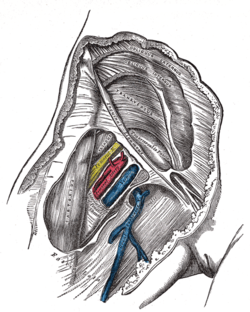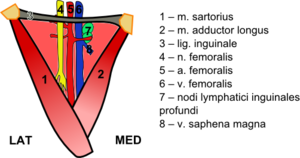Femoral Triangle: Difference between revisions
Leana Louw (talk | contribs) No edit summary |
No edit summary |
||
| (6 intermediate revisions by 3 users not shown) | |||
| Line 7: | Line 7: | ||
== Description == | == Description == | ||
The femoral triangle is a hollow region located in the supero-medial part of the anterior thigh. It appears most prominently with hip flexion, abduction and internal rotation. It is an easily accessible area through which multiple neurovascular structures pass through. This anatomical landmark is mostly used in dissection and describing relationships in the groin area.<ref name=":0">Moore KL, Dalley AF, Agur AMR. Clinial oriented anatomy. Philadelphia: Wolters Kluwer, 2010.</ref> It is also known as"scarpa's triangle" and "femoral trigone". | The femoral triangle is a hollow region located in the supero-medial part of the anterior thigh. It appears most prominently with hip flexion, abduction and internal rotation. It is an easily accessible area through which multiple neurovascular structures pass through. This [[:Category:Anatomical Landmarks|anatomical landmark]] is mostly used in dissection and describing relationships in the groin area.<ref name=":0">Moore KL, Dalley AF, Agur AMR. Clinial oriented anatomy. Philadelphia: Wolters Kluwer, 2010.</ref> It is also known as "scarpa's triangle" and "femoral trigone". | ||
{{#ev:youtube|5ggTRznMnyw}} | {{#ev:youtube|5ggTRznMnyw}} | ||
| Line 17: | Line 17: | ||
**Femoral vein - The great saphenous vein drains into the femoral vein within the triangle | **Femoral vein - The great saphenous vein drains into the femoral vein within the triangle | ||
**Femoral canal - Contains lymph nodes and vessels | **Femoral canal - Contains lymph nodes and vessels | ||
**Superfical and deep inguinal lymph nodes and vessels[[File:Femoral triangle.png|thumb|312x312px|none]] | **Superfical and deep inguinal lymph nodes and vessels[[File:Femoral triangle.png|thumb|312x312px|none|Right femoral sheath laid open to show its three compartments]] | ||
== Borders == | == Borders == | ||
The femoral triangle has three borders namely:<ref name=":0" /> | The femoral triangle has three borders namely:<ref name=":0" /> | ||
| Line 24: | Line 24: | ||
*Medial: Medial border of the [[Adductor Longus|adductor longus ''' ''' ]] | *Medial: Medial border of the [[Adductor Longus|adductor longus ''' ''' ]] | ||
*Apex: Cross between medial and lateral border | *Apex: Cross between medial and lateral border | ||
[[File:Femoral triangle2.png|thumb|none]] | [[File:Femoral triangle2.png|thumb|none|Femoral triangle, contents and borders]] | ||
== Floor and roof == | == Floor and roof == | ||
| Line 37: | Line 37: | ||
* Haematoma | * Haematoma | ||
* Nodal enlargement | * Nodal enlargement | ||
* Femoral artery | * Femoral artery aneurysm | ||
* Femoral vein [[Thrombophlebitis|thromobplebitis]] | * Femoral vein [[Thrombophlebitis|thromobplebitis]] | ||
* Femoral [[Hernia|hernias]] (mostly at proximal opening, a weak areas in the lower abdominal wall) | * Femoral [[Hernia|hernias]] (mostly at proximal opening, a weak areas in the lower abdominal wall) | ||
Clinically, the area is also commonly used for the following:<ref>Ken Hub. Femoral Triangle. Available from: https://www.kenhub.com/en/library/anatomy/femoral-triangle (accessed 22/07/2020).</ref> | Clinically, the area is also commonly used for the following:<ref>Ken Hub. Femoral Triangle. Available from: https://www.kenhub.com/en/library/anatomy/femoral-triangle (accessed 22/07/2020).</ref> | ||
* Femoral pulse palpation | * Femoral [[Pulse Rate|pulse]] palpation | ||
* Drawing blood from the femoral artery | * Drawing blood from the femoral artery | ||
* Vascular catheterization for interventional and corrective procedures | * Vascular catheterization for interventional and corrective procedures | ||
** Provides access to ipsilateral and contralateral leg, abdominal, thoracic and cerebral vessels | ** Provides access to ipsilateral and contralateral leg, abdominal, thoracic and cerebral vessels | ||
** Femoral artery catherization to access the aortic arch through the abdominal and descending aorta as well as the left side of the heart. | ** Femoral artery catherization to access the aortic arch through the abdominal and descending aorta as well as the left side of the heart. | ||
*** Used in aortic valve replacements, angiography and angioplasty | *** Used in [[Aortic Valve Disease|aortic valve replacements]], angiography and angioplasty | ||
** Femoral vein: Access right side of heart via inferior vena cava. | ** Femoral vein: Access right side of heart via inferior [[Vena Cava|vena cava.]] | ||
*** Used with patent foramen ovale repair. | *** Used with patent foramen ovale repair. | ||
| Line 55: | Line 55: | ||
[[Category:Anatomy]] | [[Category:Anatomy]] | ||
[[Category:Anatomical Landmarks]] | [[Category:Anatomical Landmarks]] | ||
[[Category:Hip]] | |||
[[Category:Hip - Anatomy]] | |||
Latest revision as of 21:36, 1 August 2023
Original Editors - Shanice Basdeo
Top Contributors - Leana Louw, Shanice Basdeo, Kim Jackson, Lucinda hampton, George Prudden and Wanda van Niekerk
Description[edit | edit source]
The femoral triangle is a hollow region located in the supero-medial part of the anterior thigh. It appears most prominently with hip flexion, abduction and internal rotation. It is an easily accessible area through which multiple neurovascular structures pass through. This anatomical landmark is mostly used in dissection and describing relationships in the groin area.[1] It is also known as "scarpa's triangle" and "femoral trigone".
Contents[edit | edit source]
The following structures pass through the femoral triangle:[1]
- Femoral nerve - Which innervates the anterior compartment of the thigh
- Femoral sheath containing:
- Femoral artery and branches - Arterial supply for majority of the lower limb
- Femoral vein - The great saphenous vein drains into the femoral vein within the triangle
- Femoral canal - Contains lymph nodes and vessels
- Superfical and deep inguinal lymph nodes and vessels
Borders[edit | edit source]
The femoral triangle has three borders namely:[1]
- Superior (base of triangle): Inguinal ligament
- Lateral: Medial border of the sartorius muscle
- Medial: Medial border of the adductor longus
- Apex: Cross between medial and lateral border
Floor and roof[edit | edit source]
The floor of the femoral triangle is comprised of the adductor longus, pectineus (medially), psoas major and illiacus muscles (laterally).[1] The floor is gutter shaped since all the muscles forming the floor pass to the posterior aspect of the femur.[1]
The roof of the femoral triangle consists of skin, superficial and deep fascia (fascia lata, cribiform fascia) of the the thigh and subcutaneous tissue.[1]
Clinical Significance[edit | edit source]
Assessment of pain and swelling in this area can be done by palpation or ultrasound. It is mostly caused by the following:[2]
- Abscesses
- Cellulitis
- Haematoma
- Nodal enlargement
- Femoral artery aneurysm
- Femoral vein thromobplebitis
- Femoral hernias (mostly at proximal opening, a weak areas in the lower abdominal wall)
Clinically, the area is also commonly used for the following:[3]
- Femoral pulse palpation
- Drawing blood from the femoral artery
- Vascular catheterization for interventional and corrective procedures
- Provides access to ipsilateral and contralateral leg, abdominal, thoracic and cerebral vessels
- Femoral artery catherization to access the aortic arch through the abdominal and descending aorta as well as the left side of the heart.
- Used in aortic valve replacements, angiography and angioplasty
- Femoral vein: Access right side of heart via inferior vena cava.
- Used with patent foramen ovale repair.
References[edit | edit source]
- ↑ 1.0 1.1 1.2 1.3 1.4 1.5 Moore KL, Dalley AF, Agur AMR. Clinial oriented anatomy. Philadelphia: Wolters Kluwer, 2010.
- ↑ Gitschlag KF, Sandler MA, Madrazo BL, Hricak H, Eyler WR. Disease in the femoral triangle: sonographic appearance. American Journal of Roentgenology 1982 Sep 1;139(3):515-9.
- ↑ Ken Hub. Femoral Triangle. Available from: https://www.kenhub.com/en/library/anatomy/femoral-triangle (accessed 22/07/2020).








